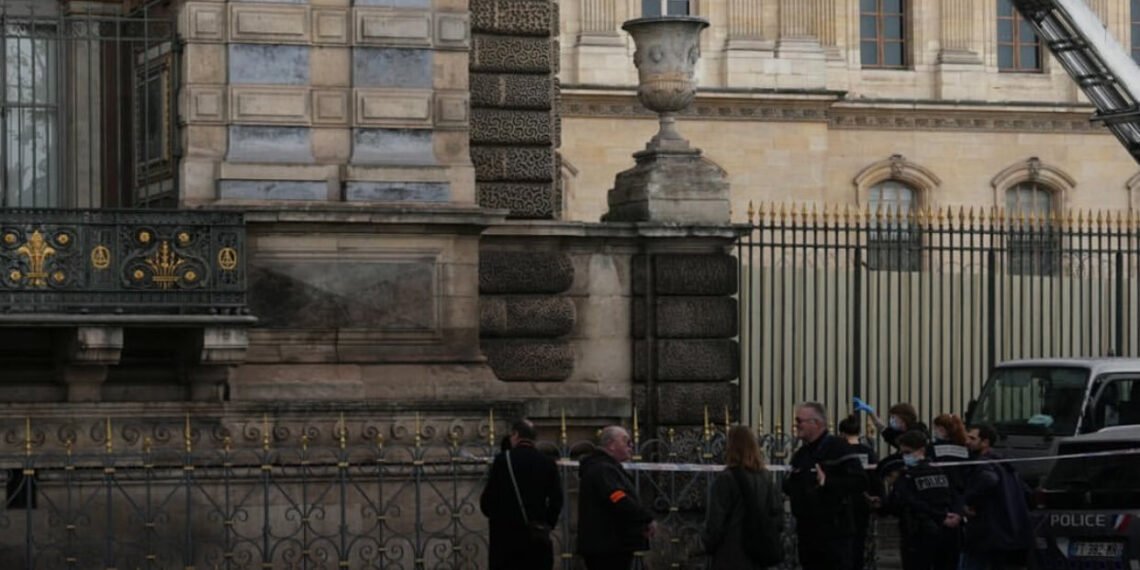Experts warn the black market can melt, recut, and scatter jewels within 48 hours, erasing historical provenance. The heist sparks criticism of museum security, cultural loss, and political fallout, as the Louvre and authorities scramble for answers.
BY PC Bureau
October 22, 2025 – Three days after the audacious October 19 heist at the Louvre Museum, where four thieves stole eight Napoleonic-era French Crown Jewels valued at €88 million ($102 million) from the Galerie d’Apollon, the case remains unresolved. The museum reopened today under heightened security, yet no arrests have been made. Art crime experts now warn of a grim reality: the stolen jewels may already be dismantled, their historical integrity destroyed, leaving little hope of recovery even if the perpetrators are apprehended.
The Heist: A Surgical Strike
The seven-minute robbery was executed with chilling precision at 9:30 a.m. on October 19. Disguised as construction workers, the thieves used a stolen truck with an extendable crane to reach a second-floor balcony window, cut through reinforced glass with a low-vibration angle grinder, and smashed three bulletproof display cases to seize eight pieces from the 19th-century imperial collection. They fled on motorbikes, leaving a damaged Empress Eugénie crown behind and setting a small fire in the truck to destroy evidence.
The speed, planning, and insider-like knowledge—evading motion sensors and exploiting a lightly staffed Sunday morning—suggest a professional organized crime operation, likely Eastern European, according to Paris police.
READ: Analysis: Himanta’s New Polarisation Weapons – Love Jihad, Polygamy Bills
READ: Back Home After 50 years, Th. Muivah Warns Against Betrayal of Naga Mandate
The Stolen Jewels: Irreplaceable but Vulnerable
The haul included iconic pieces such as Empress Marie-Louise’s emerald necklace and earrings (€37 million combined), Empress Eugénie’s diamond tiara and corsage bow brooch (€33 million), and Queen Marie-Amélie’s sapphire earring (€8 million). Gifted by Napoleon to his wives and consorts, these artifacts are prized not only for their gems—emeralds, sapphires, diamonds, and pearls—but also for their historical provenance, documented in royal portraits and coronations. However, their composition makes them especially vulnerable to dismantling.
Expert Consensus: Dismantled and Untraceable
Art crime specialists are unanimous in their pessimism about recovering the jewels intact, citing the black market’s brutal efficiency. Arthur Brand, a Dutch art detective known for recovering stolen works, told The Guardian: “These pieces are too recognizable to sell whole. Within 48 hours, they’re likely pried apart, gems recut, and gold melted. The history’s gone.”
READ:
‘It is very difficult to recover these items.’
Following a robbery at the Louvre in Paris, Charlotte Chambers Farah from The Art Loss Register explains how quickly jewellery can be melted down and move across borders.https://t.co/WCgsFZUIXI
📺 Sky 501 pic.twitter.com/duptE58NL2
— Sky News (@SkyNews) October 19, 2025
Here’s why experts believe the jewels are likely lost, even if the thieves are caught:
- Black Market Dynamics: Unlike paintings (e.g., the Mona Lisa, famously stolen in 1911), jewelry is “liquid.” Gems can be removed, recut, and sold to unsuspecting buyers or shady dealers in markets like Antwerp or Dubai. Gold and platinum settings are melted into untraceable ingots. Dr. Noah Charney, founder of the Association for Research into Crimes Against Art, notes: “A 200-carat emerald necklace becomes 20 anonymous 10-carat stones in days. Provenance is erased.”
- Precedent from Past Heists: Historical cases reinforce this fear. In the 2019 Dresden Green Vault heist, €113 million in 18th-century jewels were stolen; only fragments were recovered after arrests, with most gems recut or missing. Similarly, the 2015 Hatton Garden theft in London saw £14 million in jewels largely unrecovered. Interpol’s Stolen Works of Art database, while proactive, recovers less than 10% of loot once gems are separated.
- Speed of the Trade: The Louvre thieves’ professional execution suggests pre-arranged buyers. Robert Wittman, a former FBI art crime specialist, told Le Figaro: “These gangs work with fences who move gems within hours via private jets or couriers to Asia or the Middle East. By now, the emeralds could be in Hong Kong.” Experts estimate a 90% chance the jewels were dismantled by October 21.
- Limited Forensic Leads: Even if the thieves are caught, recovering the loot is unlikely. The burned truck yielded partial fingerprints and DNA, enough to identify suspects but not the jewels’ location. The dropped Eugénie crown, damaged during the heist, is the only recovered piece—and it’s cracked, with two emeralds missing. Brand adds: “Arrests might lead to the gang, but the client who paid for the hit already has the stones.”
Investigation Challenges: A Race Against Time
The Paris Police Prefecture’s 60-member task force, with Interpol support, is chasing multiple leads: CCTV footage of motorbikes fleeing toward the banlieues, a stolen Lille rental truck, and a possible link to a September 2025 gold theft at the Paris Natural History Museum. A public hotline has received over 200 tips, though most have proved dead ends. Experts like Charney warn that each passing day reduces recovery odds: “After a week, it’s under 5%. After a month, it’s effectively zero.” The absence of a ransom demand—a common tactic in painting thefts but rare for jewels—further indicates a “smash-and-sell” operation.
Cultural Loss and Political Fallout
The heist’s cultural impact is devastating. The jewels, symbols of France’s imperial past, are “irreplaceable,” according to Louvre director Laurence des Cars, who reportedly offered her resignation, rejected by Culture Minister Rachida Dati. On X, users mourned the loss: “Napoleon’s legacy, shattered for quick cash.” Politically, the theft has fueled criticism of museum underfunding and lax security, with far-right leaders like Jordan Bardella calling it a “national disgrace.” A Senate inquiry is probing why a €10 million 2024 security upgrade failed to prevent the breach.
Slim Hope, Stark Reality
While Interpol has flagged the jewels globally and police continue to urge public tips via +33 1 53 71 40 00, experts remain blunt: Wittman sums it up: “We might catch the thieves, but the jewels? They’re gone—melted, recut, scattered. France lost a piece of its soul.”
As the manhunt continues, attention is shifting from recovery to prevention, prompting museums worldwide to rethink security for portable, high-value artifacts. For now, the Louvre’s empty display cases stand as a haunting reminder of a heritage likely lost forever.













